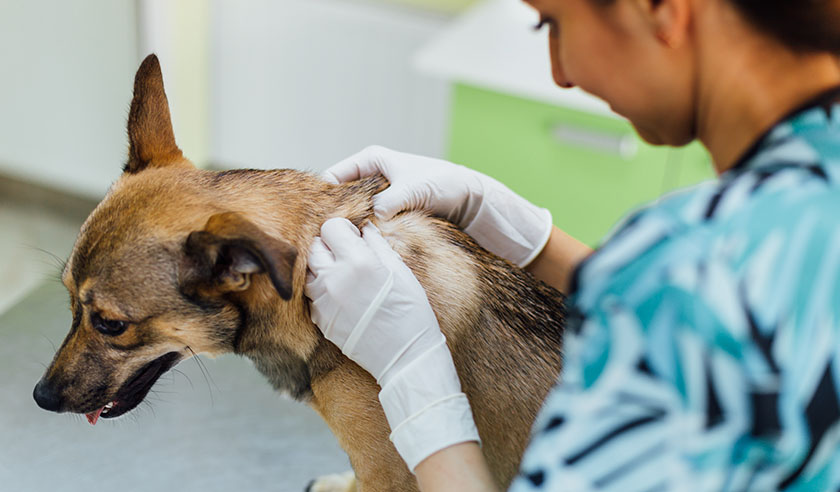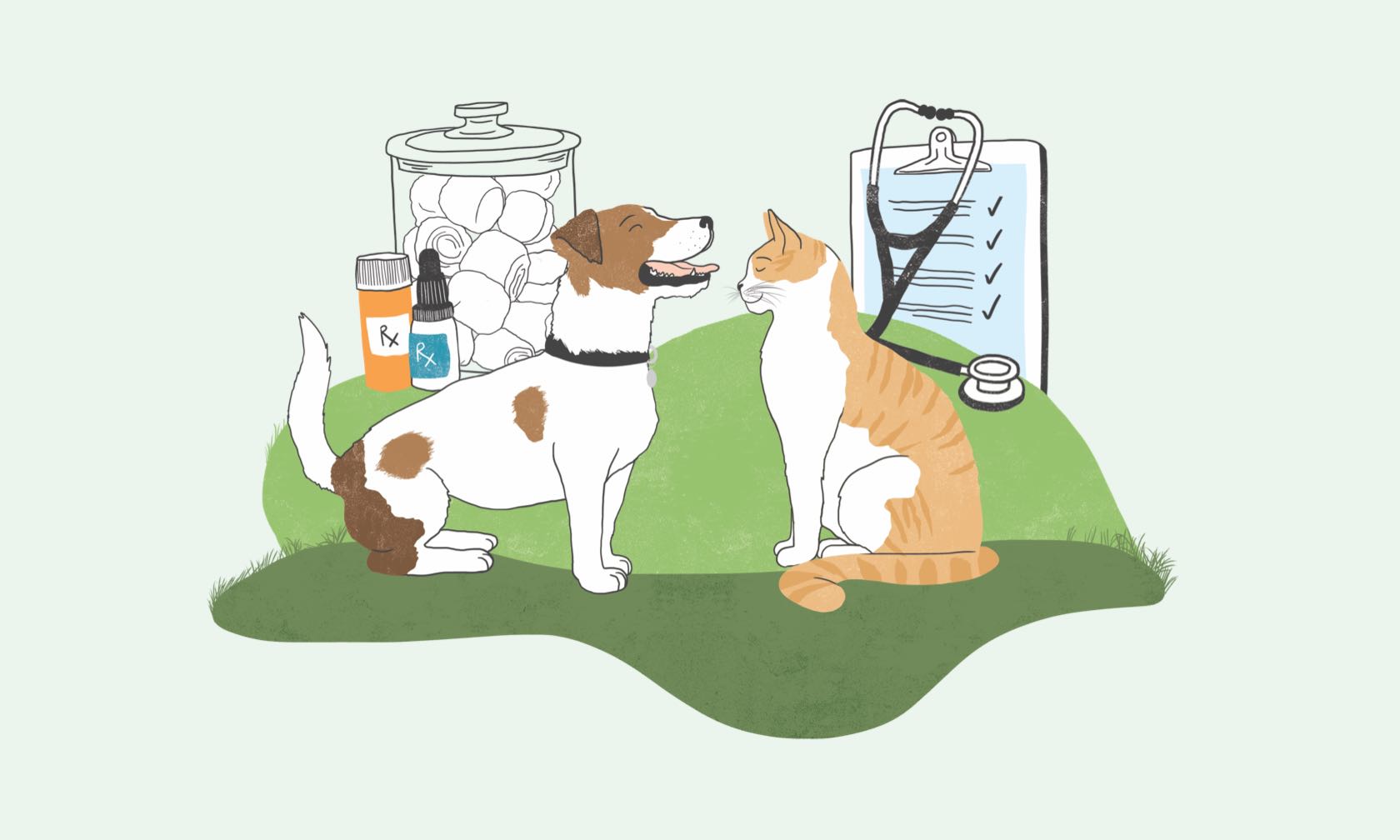Just like humans, your pet gets itchy sometimes. While all pets itch occasionally, if it interferes with normal activities or leads to hair loss, redness, odor or sores, it could be a sign of a medical condition.
Itching can be a nuisance when you wake up at night because of the sound of your pet scratching or licking or you have to vacuum up more hair and dander around your home. Itching also can be a very distressing and sometimes painful condition for them. Repeated scratching at the same area can cause irritation and breaks in the skin, increasing the chance of an infection.
You know your pet best and it’s important to notice when they’re itching more or when their skin and coat doesn’t look like it normally does.

Signs That Your Pet’s Itch Might Be Due to an Underlying Medical Condition (Such as Allergies or Skin Infection):
- Licking, biting, chewing, or scratching
- Rolling, scooting, or rubbing more than usual
- Hair loss
- Foot chewing and odor
- Reoccurring ear problems and head shaking
- Changes in the skin, like sores or darkened color
- Redness of the skin
- Body odor
- Frequent problems with their anal glands
If your pet is displaying any of these signs, it’s a good idea to head to your veterinarian as soon as possible so they can help you get to the bottom of your pet’s itch. There are many different medical conditions that can cause pets to itch, some of which can even be contagious to you. The sooner your pet’s itchy skin problem is diagnosed and treated, the happier everyone will be.
What to Expect at Your Pet’s Vet Visit
When you visit the veterinarian for your cat or dog’s skin, the first thing they will do is get a good medical history on your pet by asking you a series of questions. This may be done in the exam room or they may have you fill out a history form at home before the visit or in the waiting room.
Expect to be asked (and be prepared to answer) questions like:
- Describe the itching and skin problem - where on the body do they itch or lick most?
- How did the problem start and how long has it been going on?
- Does your pet itch more during certain seasons of the year or is it the same all year long?
- Are they currently on a flea and tick preventative - all year long or only during warm weather?
- What foods and treats are they currently eating? Bring photos of labels and ingredients.
- Do they itch or lick more after going outside? After sleeping on the bed? After eating?
- What treatments have been tried in the past and what do you think helped most? (Bring previous prescription and OTC medications to the visit.)
Your veterinarian will then perform a thorough physical examination of your pet’s skin, ears, and haircoat. They will likely recommend further in-clinic diagnostic testing such as skin scrapings and impressions of the skin to check for mites, bacteria and yeast under the microscope. These tests are fast, relatively inexpensive, and can give the veterinarian good information as to the cause of your pet’s skin problem.
Common Itchy Medical Conditions
Fleas
These little blood-sucking, disease-transmitting pests are one of the most common causes of itch in cats and dogs. Flea allergy dermatitis develops when the pet becomes allergic to the flea’s saliva and can lead to severe itching and infection, especially over the back half of the body.
Allergies
Allergies can come in many forms. Your pet can be allergic to fleas, their food or treats, dust mites, pollens, grasses and other plants, wool, and a host of other things in their environment. According to a 2018 Banfield State of the Pet Health report, dogs that have allergies are 6x more likely to develop skin infections, while cats with allergies are 15x more likely to develop them[1].
Bacterial and Yeast Infections
Very small numbers of bacteria and/or yeast on your pet’s skin are normal, but when those microbe numbers skyrocket and a true skin infection sets in, that’s when the itchiness really gets out of hand. Most skin infections in dogs and cats are secondary to underlying allergies or parasites.
Ringworm
This skin condition, caused by a fungus and not a worm, can cause itch (and the infection can spread to people).
Hot Spots
This common itchy and often painful skin problem in dogs first appears as a moist, bald or fur-matted area of skin. Common areas include the rump, base of the ear or in fold areas. After clipping the area, red oozing sores can be seen. Often the size of the hot spot is much larger and more severe than it appears at first before clipping. While they can arise just from an area of skin not being dried well enough following a bath or swim, they’re most often a sign of an allergy or fleas.
Treatment Options for Itching
There are many highly effective and safe treatment options available from your veterinarian to give your pet relief from itching and skin infections. Over-the-counter and online remedies are unlikely to help. The first step is making an appointment to see your veterinarian. Make sure that your pet — and all other pets in your home — are on safe, effective, and consistent flea prevention, as fleas are often a culprit that makes your pet itchy.
Your veterinarian will start a diagnostic exam to find the cause of your pet’s itch. Parasites such as fleas and mites, and skin infections, are ruled out first. Your vet will also start your pet on appropriate medications and therapies to relieve their itch.
If the itch continues, or goes away but then comes back once your pet's treatment stops, then the vet will look for other causes such as food and environmental allergies. If the previous step does not find the cause, then hormonal testing and skin biopsy may be needed to diagnose other less common causes of itch.
The best treatment for your pet will depend on what’s causing them to feel itchy. Just treating symptomatically (the "quick fix”) without finding the cause of the itch often leads to a pet's signs worsening over time and the development of resistant skin infections. While we are trying to find the cause, there are different options ranging from tablets to injectables to help stop your pet’s itch and treat skin infections. Your veterinarian will partner with you to find the best tailored treatment that works for you and your pet.
If your pet is not responding to treatment, has repeated episodes of itchiness, or continues to have flares of itch and skin and ear infections, your veterinarian may recommend that your pet see a veterinarian dermatologist. A board-certified veterinary dermatologist is a veterinarian who specializes in skin and ear problems and has expertise in treating challenging dermatology cases. These specialists can help relieve your pet's itchiness and help get their skin disease under control.
ZPC-00302R2
- Banfield 2018 State of Pet Health® Report: The Science Behind Skin Allergies





